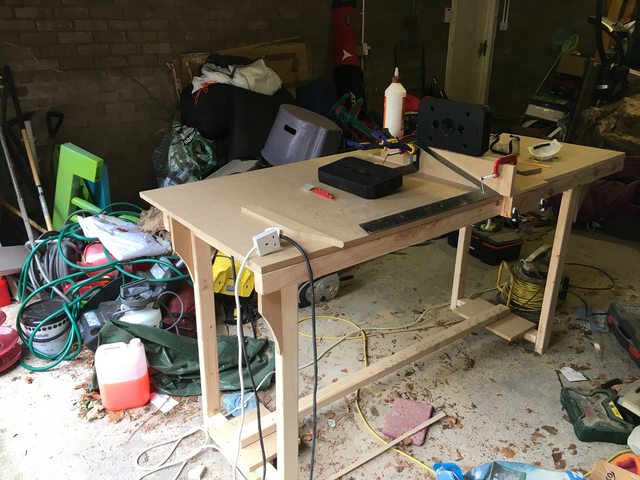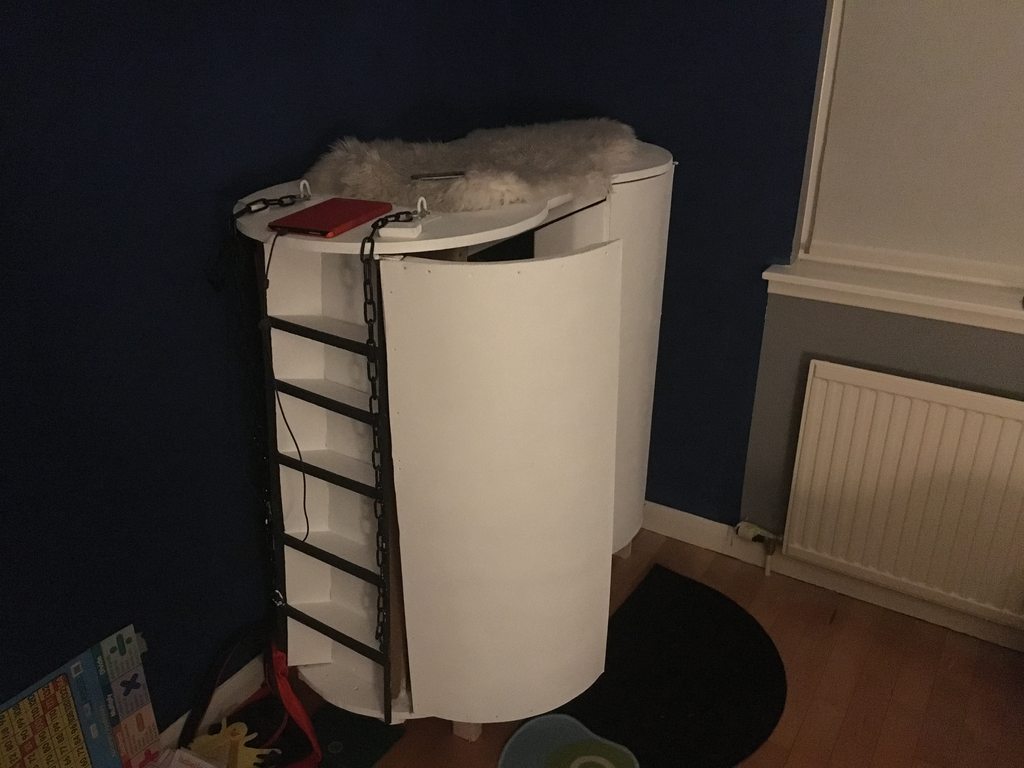Ok, I'm new to this and pretty much completely inexperienced so go easy (ish). I'm not even sure I've posted this in the right area...
I have some limited ability at general handywork and have a few cheap and poor quality handheld power tools (circular saw, jigsaw, reciprocating saw) - you know, the kind of things that novices buy cheaply when we don't know better, in order to do a job which could be done with hand tools if we were a bit more capable (or patient). The one upgrade I've made to the circular saw, which I use more than anything of the rest is to swap the blade for a marginally better 40t combi blade from Saxton (only a tenner but seems a lot smoother than the ripping blade for everything, including ripping!) I have cordless powerdrills and the like too.
Over the last however many years, I've built a series of "bookcase" shelves in my study which are functional, butt-ugly but straight, solid enough and highlight where I need to improve my skills (design and execution). Basically, I know which end of the saw to hold and can use it in a fairly utilitarian fashion.
We are moving to a new house and I would like to "get into" woodwork far more. I have young children, so the eventual possibility of making stuff for them (and for the house) appeals massively. Our new house will have a large enough garage to act as a workshop and storage area for kit, so that's that part sorted. I won't have enough space for huge fixed standing equipment but anything on castors which can be folded to less than 1m wide should be feasible. I have time at weekends, although this is shared between spending it with my family, potentially having to do stuff with the new house, hillwalking and climbing, photography and cooking. A few calls on my time, so the ability to spend 8-10 hours every weekend planing, turning, chiseling and handsawing is just not practical - hence the reason I'm focusing on the power tool side of woodworking (sorry to the "proper" woodworkers out there).
Aside from longer term objectives, what do I want to build? Things like frames for canvasses (so not visible - hence I'm assuming easier) and eventually maybe even picture frames, but I realise they are far more mm-perfect so not for the beginner (but would be useful for my photography). More functional, but hopefully more attractive, workstations etc. for my study (doesn't need to be as pretty as cabinets or fine furniture) could also be an eventual aim.
So, a very long journey ahead of me, but one I'm willing to invest in slowly as I build up my skills (and get sign off from the boss inside to buy & keep more kit). The question is, what should I invest it, apart from spending as much time as possible practicing, making stuff (even badly) and following youtube instructional videos? My poorly informed thoughts at the moment are:
1. Buy some essential (non-powered) tools: speed or combination square, spring clamps and quick release U clamps, 1m metal rule, depth gauge for lining up on homemade jigs and some decent woodglue
2. Buy two 3' saw horses and get my hands on a big straight, thick piece of old timber as a worksurface - an old flat door perhaps. Buy a sheet or two of 12mm or 18mm ply for "playing"
3. Build a couple of fences for my circular saw for rip cuts and cross cuts (maybe also a 45 degree mitre) for frames and things like cornerclamps, wedges etc. for fixing.
4. Get building! Canvas frames and maybe even simple utilitarian boxes for tools which can eventually hang on the wall (or go onto draw rails and into an eventual housing) - stuff that will be hidden away from sight but gets me used to using the tools I have and jigs to build things square and accurately (ish). Get used to trying to cut to the nearest mm with homemade jigs and fixing sides square with clamps and homemade corner clamps etc.
5. Eventually move onto a table saw - buy vs convert the circular saw? Head is telling me to stump up some readies for a good quality second hand one rather than try to cobble something together which won't be square
6. Anything else? I don't envisage cutting wiggly shapes, so a bandsaw isn't a priority (unless you think it is) and worst case I have a jigsaw to make do for occasional requirements. Mitre saw? Again, the circular saw with jig should be able to deal with what I need, most of the time? Maybe a cheaper brad/nail gun for quick fixing?
Sorry for the long and rambling post - especially if it's in the wrong bit of the forum (moderators feel free to move as necessary)... just after a bit of advice. I'm not likely to be in a position to set up shop before we move as we're moving into temporary (smaller) accommodation for two months at the end of this month and won't have much space. So I have plenty of time with just essentials to play and learn...
Thanks in advance.
I have some limited ability at general handywork and have a few cheap and poor quality handheld power tools (circular saw, jigsaw, reciprocating saw) - you know, the kind of things that novices buy cheaply when we don't know better, in order to do a job which could be done with hand tools if we were a bit more capable (or patient). The one upgrade I've made to the circular saw, which I use more than anything of the rest is to swap the blade for a marginally better 40t combi blade from Saxton (only a tenner but seems a lot smoother than the ripping blade for everything, including ripping!) I have cordless powerdrills and the like too.
Over the last however many years, I've built a series of "bookcase" shelves in my study which are functional, butt-ugly but straight, solid enough and highlight where I need to improve my skills (design and execution). Basically, I know which end of the saw to hold and can use it in a fairly utilitarian fashion.
We are moving to a new house and I would like to "get into" woodwork far more. I have young children, so the eventual possibility of making stuff for them (and for the house) appeals massively. Our new house will have a large enough garage to act as a workshop and storage area for kit, so that's that part sorted. I won't have enough space for huge fixed standing equipment but anything on castors which can be folded to less than 1m wide should be feasible. I have time at weekends, although this is shared between spending it with my family, potentially having to do stuff with the new house, hillwalking and climbing, photography and cooking. A few calls on my time, so the ability to spend 8-10 hours every weekend planing, turning, chiseling and handsawing is just not practical - hence the reason I'm focusing on the power tool side of woodworking (sorry to the "proper" woodworkers out there).
Aside from longer term objectives, what do I want to build? Things like frames for canvasses (so not visible - hence I'm assuming easier) and eventually maybe even picture frames, but I realise they are far more mm-perfect so not for the beginner (but would be useful for my photography). More functional, but hopefully more attractive, workstations etc. for my study (doesn't need to be as pretty as cabinets or fine furniture) could also be an eventual aim.
So, a very long journey ahead of me, but one I'm willing to invest in slowly as I build up my skills (and get sign off from the boss inside to buy & keep more kit). The question is, what should I invest it, apart from spending as much time as possible practicing, making stuff (even badly) and following youtube instructional videos? My poorly informed thoughts at the moment are:
1. Buy some essential (non-powered) tools: speed or combination square, spring clamps and quick release U clamps, 1m metal rule, depth gauge for lining up on homemade jigs and some decent woodglue
2. Buy two 3' saw horses and get my hands on a big straight, thick piece of old timber as a worksurface - an old flat door perhaps. Buy a sheet or two of 12mm or 18mm ply for "playing"
3. Build a couple of fences for my circular saw for rip cuts and cross cuts (maybe also a 45 degree mitre) for frames and things like cornerclamps, wedges etc. for fixing.
4. Get building! Canvas frames and maybe even simple utilitarian boxes for tools which can eventually hang on the wall (or go onto draw rails and into an eventual housing) - stuff that will be hidden away from sight but gets me used to using the tools I have and jigs to build things square and accurately (ish). Get used to trying to cut to the nearest mm with homemade jigs and fixing sides square with clamps and homemade corner clamps etc.
5. Eventually move onto a table saw - buy vs convert the circular saw? Head is telling me to stump up some readies for a good quality second hand one rather than try to cobble something together which won't be square
6. Anything else? I don't envisage cutting wiggly shapes, so a bandsaw isn't a priority (unless you think it is) and worst case I have a jigsaw to make do for occasional requirements. Mitre saw? Again, the circular saw with jig should be able to deal with what I need, most of the time? Maybe a cheaper brad/nail gun for quick fixing?
Sorry for the long and rambling post - especially if it's in the wrong bit of the forum (moderators feel free to move as necessary)... just after a bit of advice. I'm not likely to be in a position to set up shop before we move as we're moving into temporary (smaller) accommodation for two months at the end of this month and won't have much space. So I have plenty of time with just essentials to play and learn...
Thanks in advance.


































